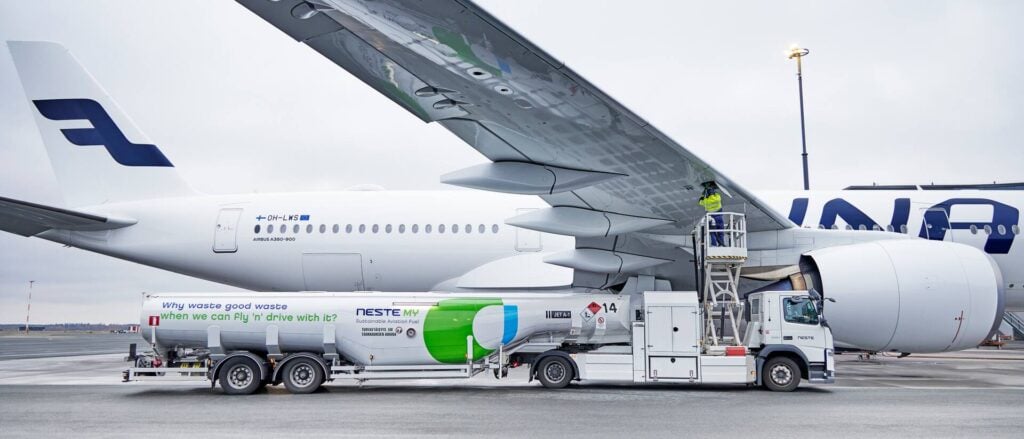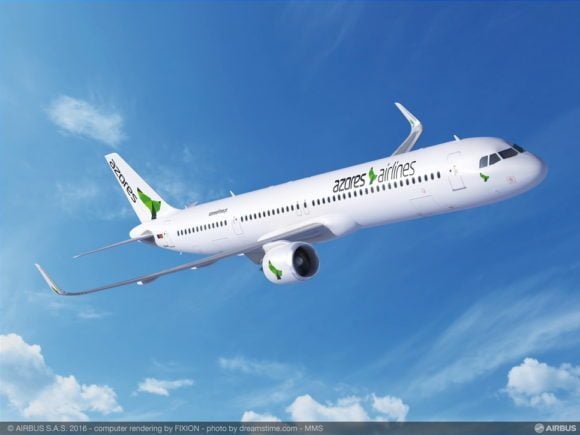
Finnair SAF refueling
What is SAF?
Sustainable Aviation Fuel (SAF) is a type of jet fuel made from renewable or waste-based sources – such as used cooking oil, agricultural residues, municipal solid waste, or even captured carbon dioxide combined with green hydrogen. Unlike experimental fuels, SAF is a “drop-in” replacement, meaning it can be blended with conventional Jet A or Jet A-1 and used in today’s aircraft engines and airport fuel systems without modifications.
On a lifecycle basis, SAF can cut carbon dioxide emissions by 50–80% (or more) compared to fossil jet fuel, depending on the feedstock and production process. It also contains fewer impurities like sulfur and aromatics, which leads to cleaner combustion, fewer soot particles, and reduced contrail formation. This is an essential factor in determining the impact of Aviation on the world’s climate.
SAF is certified under American Society for Testing and Materials (ASTM D7566/D1655)
Why Airbus and Boeing are investing in SAF?
1) Protecting the value proposition of their fleets
Airlines need aircraft that are compatible with 100% SAF so they can comply with mandates and decarbonization plans without waiting for new propulsion architectures. Both OEMs publicly target 100% SAF capability by 2030, and run large test programs (e.g., A380 and A350 on 100% SAF; 777/787/737 programs in Boeing’s Eco-Demonstrator).
2) Catalyzing supply with capital and demand signals
Airbus: Strategic partnerships and co-investments (e.g., up to $200M with Qantas to seed an Australian AF industry; collaboration with Lanza Jet / Jet Zero pathways). Airbus also uses SAF in its own operations (more than 11 million liters in 2023) and supports offtake structuring for customers.
Boeing: Multi-million-gallon SAF procurements for its operations (e.g., 5.6 million gal in 2023; 5.4 million gal in 2024 via book-and-claim), partnerships across the value chain (Alder Fuels, EPIC, World Energy, Neste), and extensive Eco Demonstrator testing on high-blend and 100% SAF.
ASTM-approved SAF pathways (2025)
To ensure safety and performance, all Sustainable Aviation Fuel (SAF) must meet strict certification standards. The American Society for Testing and Materials (ASTM) has approved several pathways that define how SAF can be produced, blended, and used in commercial aviation.
The table below outlines the current ASTM-approved pathways, their feedstocks, and blending limits as of 2025.
| Pathway | Common name | Typical feedstocks | Max blend in spec fuel |
| FT-SPK (A1) | Fischer-Tropsch Synthetic Paraffinic Kerosene | Municipal solid waste, ag residues, biomass-to-syngas | 50% |
| HEFA-SPK (A2) | Hydro-processed Esters & Fatty Acids | Used cooking oil (UCO), tallow, non-food lipids | 50% |
| SIP (A3) | Synthesized Iso-Paraffins (from sugars) | Sugars to farnesane | 10% |
| FT-SPK/A or FT-SKA (A4) | FT with aromatics | Adds synthetic aromatics | 50% |
| ATJ-SPK (A5) | Alcohol-to-Jet | Ethanol or iso-butanol | 50% (pathway-dependent) |
| CHJ (A6) | Catalytic Hydro-thermolysis Jet | Lipids | 50% |
| HC-HEFA (A7) | Hydro-carbonized HEFA (algal) | B. braunii lipids | 10% |
| ATJ-SKA (A8) | Alcohol-to-Jet with aromatics | Adds synthetic aromatics | 50% |
| Co-processing (D1655) | Petroleum unit CO2 processing | Lipids/biogenic oils in refineries | 5% biogenic content in batch |
Source: NREL (2024) – ASTM Annex Pathways; U.S. DOE AFDC – SAF pathways overview
100% SAF: When aromatics are present (via SAK/SKA) and other spec properties are met, aircraft can mechanically operate on neat SAF. Certification to use 100% SAF in regular service is the next step, targeted by both OEMs this decade.
What does the future hold for SAF?
The future of Sustainable Aviation Fuel (SAF) depends heavily on scaling up production, reducing costs, and fostering collaboration across the industry. In the short term, SAF will continue to make up only a small share of jet fuel usage due to high prices and limited feedstock. However, advances in power-to-liquid technologies, which combine green hydrogen with captured CO2, along with new feedstocks like algae and municipal waste, are expected to bring costs down and expand availability. This, coupled with regulatory mandates in regions such as the EU and the U.S, will accelerate SAF’s shift from niche adoption to a mainstream aviation fuel by the 2030s
In the longer term, SAF will serve as a critical complement to hydrogen and electric propulsion, particularly on long-haul routes where current alternatives remain technically and economically challenging. Airbus and Boeing’s push to certify their fleets for 100% SAF ensures the infrastructure will be ready once supply scales up. More than a temporary fix, SAF is a cornerstone of aviation’s net-zero strategy, and its growth will depend on sustained cooperation among governments, manufacturers, airlines, fuel producers, and even travelers to drive the industry’s sustainable future.
External References
- https://elib.dlr.de/207629/1/acp-24-11255-2024.pdf
- https://www.icao.int/CORSIA/corsia-eligible-fuels
Views: 649


